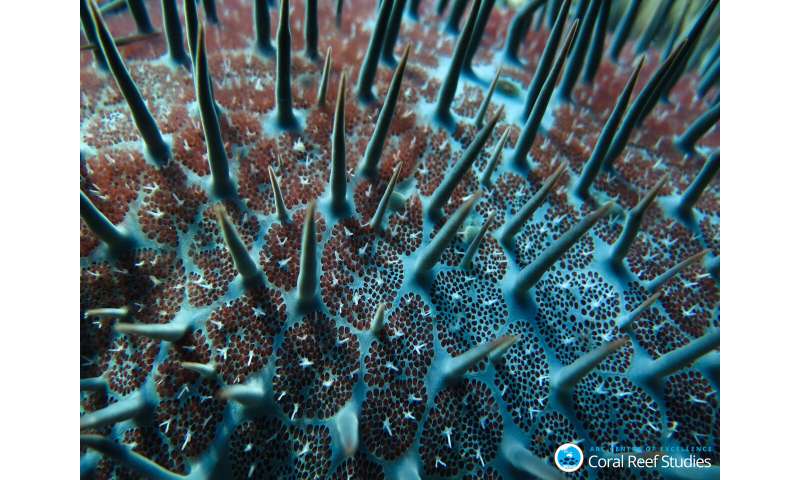by ARC Centre of Excellence for Coral Reef Studies

A close-up of a crown-of-thorns starfish. The creatures eat Acropora corals until they're effectively homeless. Credit: Morgan Pratchett.
A world-first study on the Great Barrier Reef shows crown-of-thorns starfish have the ability to find their own way home—a behavior previously undocumented—but only if their neighborhood is stocked with their favorite food: corals.
Australian researchers observed the starfish emerging from their shelters in the afternoons so they could feed on coral during the night before returning home at dawn.
"The crown-of-thorns starfish often partied all night, slept-in and only those with a well-stocked larder found their way home—so it's very much a teenager model of behavior," said lead author Dr. Scott Ling from the Institute for Marine and Antarctic Studies at the University of Tasmania.
"Their preferred prey is Acropora corals," said co-author Professor Morgan Pratchett from the ARC Centre of Excellence for Coral Reef Studies at James Cook University (CoralCoE at JCU). Acropora is an important coral species—for the past two million years they have been the building blocks of reefs across the world.
"When populations of Acropora dropped, the starfish didn't return home," Prof Pratchett said. "Their behavior is directly linked to the local abundance of Acropora."
The results of the study show healthy reefs with a high cover of these corals may encourage crown-of-thorns aggregations and outbreaks. The outbreaks cause extensive, widespread and sustained coral loss throughout the Indo-Pacific region.
Play Credit: ARC Centre of Excellence for Coral Reef Studies
Similar examples of predator infestations driving environmental devastation include sea urchins overgrazing on kelp forests and coral reef fishes munching through patches of seagrass.
The researchers used in-situ time-lapse photography to track the movements of 58 starfish in the northern and southern Great Barrier Reef during an outbreak in 2015. In the absence of their preferred Acropora coral prey, starfish were typically homeless and instead roamed up to 20 meters per day.
"Unlike sea urchins that can switch diet once they overgraze kelp forests, results of the time-lapse monitoring indicate that the starfish will consume available Acropora and ultimately eat themselves out of house and home before dispersing in search of new feeding grounds," Dr. Ling said.
Previous outbreaks on the Great Barrier Reef were recorded in 1962, 1979, 1993 and 2009. Though mass-coral bleaching due to global warming is now the greatest threat to coral reefs worldwide, the combined impact of mass-bleaching and crown-of-thorns outbreaks is potentially catastrophic for coral reefs.
"By better understanding the behavior of these starfish we can help prevent and control their outbreaks, which will help alleviate the pressures on coral reefs," Prof Pratchett said.
The study is published in the journal Proceedings of the Royal Society B.
Explore further
A world-first study on the Great Barrier Reef shows crown-of-thorns starfish have the ability to find their own way home—a behavior previously undocumented—but only if their neighborhood is stocked with their favorite food: corals.
Australian researchers observed the starfish emerging from their shelters in the afternoons so they could feed on coral during the night before returning home at dawn.
"The crown-of-thorns starfish often partied all night, slept-in and only those with a well-stocked larder found their way home—so it's very much a teenager model of behavior," said lead author Dr. Scott Ling from the Institute for Marine and Antarctic Studies at the University of Tasmania.
"Their preferred prey is Acropora corals," said co-author Professor Morgan Pratchett from the ARC Centre of Excellence for Coral Reef Studies at James Cook University (CoralCoE at JCU). Acropora is an important coral species—for the past two million years they have been the building blocks of reefs across the world.
"When populations of Acropora dropped, the starfish didn't return home," Prof Pratchett said. "Their behavior is directly linked to the local abundance of Acropora."
The results of the study show healthy reefs with a high cover of these corals may encourage crown-of-thorns aggregations and outbreaks. The outbreaks cause extensive, widespread and sustained coral loss throughout the Indo-Pacific region.
Play Credit: ARC Centre of Excellence for Coral Reef Studies
Similar examples of predator infestations driving environmental devastation include sea urchins overgrazing on kelp forests and coral reef fishes munching through patches of seagrass.
The researchers used in-situ time-lapse photography to track the movements of 58 starfish in the northern and southern Great Barrier Reef during an outbreak in 2015. In the absence of their preferred Acropora coral prey, starfish were typically homeless and instead roamed up to 20 meters per day.
"Unlike sea urchins that can switch diet once they overgraze kelp forests, results of the time-lapse monitoring indicate that the starfish will consume available Acropora and ultimately eat themselves out of house and home before dispersing in search of new feeding grounds," Dr. Ling said.
Previous outbreaks on the Great Barrier Reef were recorded in 1962, 1979, 1993 and 2009. Though mass-coral bleaching due to global warming is now the greatest threat to coral reefs worldwide, the combined impact of mass-bleaching and crown-of-thorns outbreaks is potentially catastrophic for coral reefs.
"By better understanding the behavior of these starfish we can help prevent and control their outbreaks, which will help alleviate the pressures on coral reefs," Prof Pratchett said.
The study is published in the journal Proceedings of the Royal Society B.
Explore further
More information: Homing behaviour by destructive crown-of-thorns starfish is triggered by local availability of coral prey, Proceedings of the Royal Society B, rspb.royalsocietypublishing.or … .1098/rspb.2020.1341
Journal information: Proceedings of the Royal Society B
Provided by ARC Centre of Excellence for Coral Reef Studies
Journal information: Proceedings of the Royal Society B
Provided by ARC Centre of Excellence for Coral Reef Studies
No comments:
Post a Comment